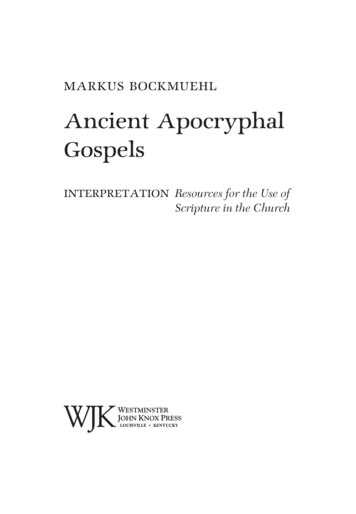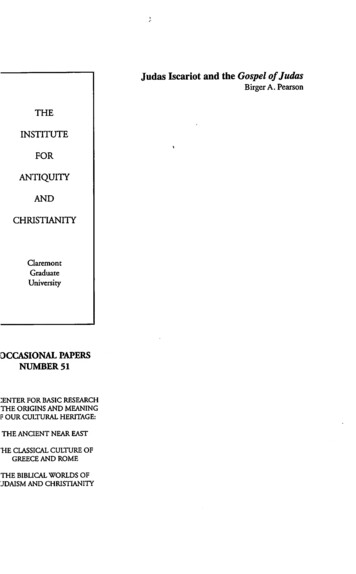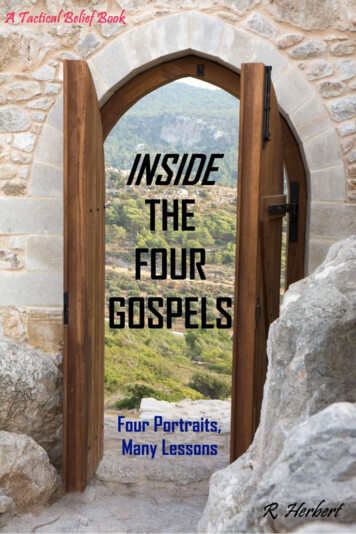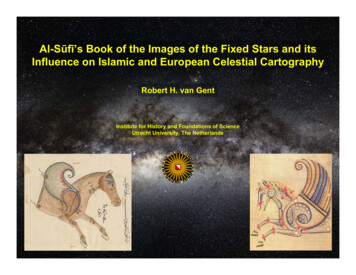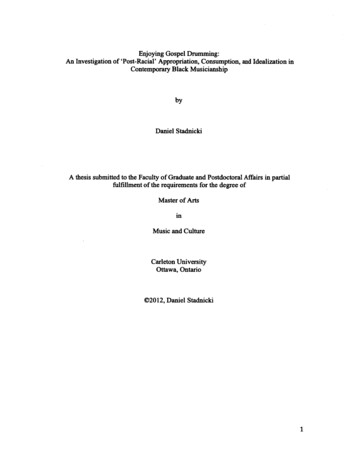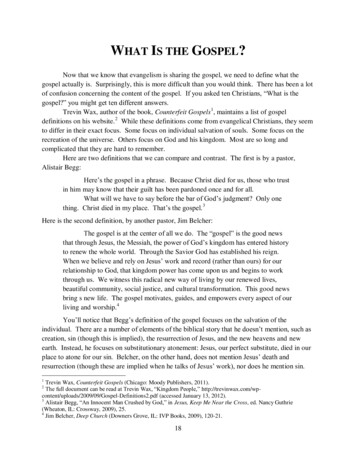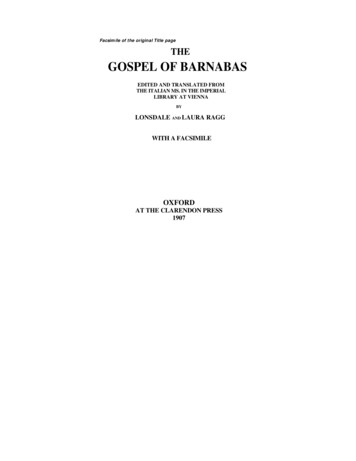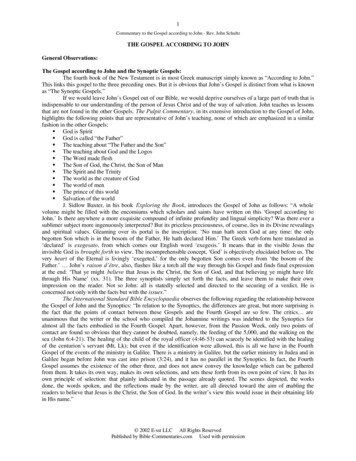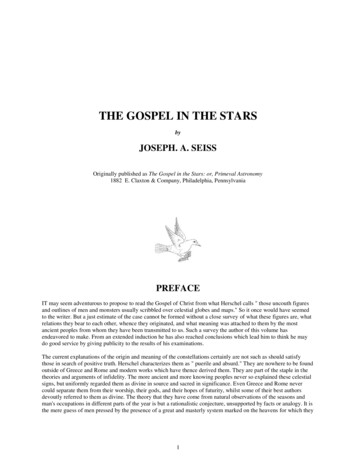
Transcription
THE GOSPEL IN THE STARSbyJOSEPH. A. SEISSOriginally published as The Gospel in the Stars: or, Primeval Astronomy1882 E. Claxton & Company, Philadelphia, PennsylvaniaPREFACEIT may seem adventurous to propose to read the Gospel of Christ from what Herschel calls " those uncouth figuresand outlines of men and monsters usually scribbled over celestial globes and maps." So it once would have seemedto the writer. But a just estimate of the case cannot be formed without a close survey of what these figures are, whatrelations they bear to each other, whence they originated, and what meaning was attached to them by the mostancient peoples from whom they have been transmitted to us. Such a survey the author of this volume hasendeavored to make. From an extended induction he has also reached conclusions which lead him to think he maydo good service by giving publicity to the results of his examinations.The current explanations of the origin and meaning of the constellations certainly are not such as should satisfythose in search of positive truth. Herschel characterizes them as " puerile and absurd." They are nowhere to be foundoutside of Greece and Rome and modern works which have thence derived them. They are part of the staple in thetheories and arguments of infidelity. The more ancient and more knowing peoples never so explained these celestialsigns, but uniformly regarded them as divine in source and sacred in significance. Even Greece and Rome nevercould separate them from their worship, their gods, and their hopes of futurity, whilst some of their best authorsdevoutly referred to them as divine. The theory that they have come from natural observations of the seasons andman's occupations in different parts of the year is but a rationalistic conjecture, unsupported by facts or analogy. It isthe mere guess of men pressed by the presence of a great and masterly system marked on the heavens for which they1
knew not how to account — a guess which will not stand the test of its own assumptions or common sense, muchless the light now in the world's possession respecting the remoter antiquities of man. That some Greek and Romanauthors, who never understood any of these things,* [* See Grote's History of Greece, vol. i. pp. 394 -444.] shouldindulge in such unfounded suppositions is not remarkable; but that people of learning and science, jealous ofbuilding on anything but solid grounds, should still entertain and reiterate theta for ascertained verities, is verysurprising. And if men are constrained thus to accept and repeat them from sheer inability otherwise to solve theproblem, it should convince them that they have not yet risen to the true character and dignity of these ancientrecords, and dispose them to a fresh and searching re-examination of the whole subject, to which this book is meantto furnish some humble aid.The first suspicion that the original constellations may perhaps have come from a divine or prophetic source wasimpressed upon the writer's mind in connection with his studies of the marvellous wisdom embodied in the GreatPyramid of Gizeh. But it came only in the shape of an inference, which needed to be tested on its own independentgrounds before it could be reasonably accepted. That inference, however, was so direct, and the subject seemed soworthy of being investigated, that a course of special study was instituted to ascertain, apart from all pyramidtheories, whether the facts and probabilities in the case would warrant a conclusion of so much moment.A new field of inquiry thus opened, for the exploration of which but few helps beyond the ordinary books onastronomy could be found. Something, however, had been done by Bailly in his History of Astronomy, Dupuis inhis L'Origines des Cultes, Volney in Les Ruines, and some other writers of the same class. To throw contempt onChristianity as a mere accommodation of certain old mythic ideas common to all primitive peoples, these menadduced a large amount of traditional and astronomic lore, proving the great antiquity of the constellations, andshowing a striking correspondence between them and the subsequent scriptural story of Christ and salvation. Abletheologians like Roberts and Faber, in making replies to these French skeptics, were obliged to admit the strongarray of facts alleged, and could only surmise a variety of explanations to do away with the intended conclusion as anon sequitur. The argument of these infidels is indeed fatally defective, especially in assuming that the oldastronomy throughout, and all the myths and worships associated with it, have come solely from the naturalobservation and imagination of man, apart from all supernatural light, revelation, or inspiration. With this startingpoint unproven and incapable of verification, and with the positive assertions of all the primeval world and all theindications directly to the contrary, the whole argument necessarily breaks down. Like all the efforts of unbelief, itsignally fails. But though the argument, as such, is false and worthless, it does not follow that the materials collectedto build it are the same. For the most part, they are solid enough in themselves, and the gathering of them was avaluable contribution to a better cause. The showings made of the close likeness between the old constellations andthe Gospel are well founded, and can now be illustrated to a much greater and more minute extent. But, instead ofproving Christianity a mere revival of old mythologies, they give powerful impulse toward the conclusion that theconstellations and their associated myths and traditions are themselves, in their original, from the very sameprophetic Spirit whence the Sacred Scriptures have come, and that they are of a piece with the biblical records in thesystem of God's universal enunciations of the Christ.Gale, in his Court of the Gentiles, Faber, On Pagan Idolatry, Roberts, in his Letters to Volney, Haslam, on TheCross and the Serpent, and the author of Primeval Man Unveiled, have slightly touched upon the subject, and furnishsome materials in the direction of the same conclusions.Sir William Drummond, in his Origines, C. Piazzi Smyth, in his Life and Work, and J. T. Goodsir, On EthnicInspiration, also present some important facts and considerations relating to the general inquiry.A more valuable aid to the study of the subject as treated in this volume is Frances Rolleston's Mazzaroth; or, TheConstellations — a book from an authoress of great linguistic and general literary attainments, whom Providencerarely favored for the collection of important facts and materials, particularly as respects the ancient stellarnomenclature. The tables drawn up by Ulugh Beigh, the Tartar prince and astronomer, about A. D. 1420, givingArabian astronomy as it had come down to his time, with the ancient Coptic and Egyptian names, likewise the muchearlier presentations, made about A. D. 850 by Albumazer, the great Arab astronomer of the Caliphs of Grenada,and Aben Ezra's commentaries on the same, are, to a considerable extent, reproduced in her book. Facsimiles of theDendera and Esne Zodiacs are also given in the last edition (1875) of her work. And from her tables and referencesthe writer of these Lectures was helped to some of his best information, without which this book could hardly havebecome what it is.2
If any others have treated directly, or even incidentally, of what is sought to be shown in this volume, its author hasnot discovered their records or their names.With but little, therefore, but the star-maps and descriptions as given by astronomers, and such notices of theconstellations as are to be found in the remains of antiquity and general literature, he had to make his way as best hecould. With what success he has done his work, and in how far his conclusions are entitled to credit or respect, henow submits to the decision of a candid and intelligent public.1 THE STARRY WORLDSAnd God said, Let there be lights in the firmament of the heavens to divide the day from the night; and let them befor signs, and for seasons, and for days, and for years.— Genesis 1:14THE sublimest visible objects of human contemplation are the Starry Heavens. The beholder is awed at everythoughtful look upon them. And when viewed in the light of astronomical science the mind is overwhelmed and lostamid the vastness and magnificence of worlds and systems which roll and shine above, around and beneath us.THE SUNThe most conspicuous, to us, of these wonderful orbs is the Sun. Seemingly, it is not as large as the wheel of awagon, but when we learn that we see it only at the distance of more than ninety-one millions of miles, and considerhow the apparent size of objects diminishes in proportion to their remoteness, we justly conclude that it must be of3
enormous magnitude to be so conspicuous across a gulf so vast. Our earth is a large body; it takes long and toilsomejourneying for a man to make his way around it. But the Sun fills more than a million times the cubic space filled bythe earth. A railway-train running thirty miles an hour, and never stopping, could not go around it in less than elevenyears, nor run the distance from the earth to the Sun in less than three hundred and sixty years. If we were to take astring long enough to reach the moon, and draw a circle with it at its utmost stretch, the Sun would still be six timeslarger than that circle. Belonging to the system of which it is the centre there are eight primary planets, some of themmore than a thousand times larger than our earth, besides eighty-five asteroids, twenty-one satellites or moons, andseveral hundred comets. But the Sun itself is six hundred times greater than all these planets and their satellites puttogether. The greatest of them might be thrown into it, and would be to it no more than a drop to a bucket, a birdshot to a cannon-ball, or an infant's handful to a bushel measure.THE VASTNESS OF THE UNIVERSEBut, great and glorious as the Sun is, and seemingly so much greater than every other object in the sky, it is reallyonly a tiny fragment, a mere speck, in the magnificent starry empire of which it is a part. It is less to the materialuniverse at large than a globule to our globe. With all its retinue of ponderous orbs, it is only one of innumerablehosts of such suns and systems. There are myriads of stars in space immeasurably greater than it. They look verydiminutive in comparison with it, but they are hundreds of thousands of times farther off. A ball shot from a cannonand moving at the rate of five hundred miles an hour could not reach the nearest of them in less than thirteenmillions of years. Light is the rapidest of known travellers. A ray from the Sun reaches us in about eight and aquarter minutes. But there are some stars in these heavens known to be so remote that if a ray of light had startedfrom them direct for our world when Adam drew his first breath, it would hardly yet have reached the earth. Siriusalone gives out nearly four hundred times as much light as the Sun, and yet Sirius is a star of moderate size amongthe stars. The Sun is no more to many other stars than one of our smaller planets is to it. We know that the Sun turnson its axis as the earth turns, and that it is ever moving on a journey around some transcendently greater centre, justas the earth and other planets revolve around it as their centre. It takes the earth one year to complete its revolutionaround the Sun, but it takes the Sun eighteen millions of our years to make its revolution around the centre which itobeys.We are amazed and overwhelmed in the contemplation of worlds and systems so vast. But there is solid reason forbelieving that all these tremendous systems, in which uncounted suns take the place of planets, are themselves butsatellites of still immeasurably sublimer orbs, and thus on upward, through systems on systems, to some supremephysical Omnipotent, where the unsearchable JEHOVAH has His throne, and whence He gives forth His invinciblelaws to the immensity of His glorious realm.These are the "lights," light-bearers, or luminaries to which the text refers, and which the potent creative Word hasbrought into being and placed in the firmament of the heaven.OBJECTS OF THESE MATERIAL CREATIONSSuch wonderful creations of almighty power and wisdom were not without a purpose. It was the will of the eternalGod to be known — to have creatures to understand and enjoy His glory — to provide for them suitable homes —to acquaint them with His intelligence, power, and perfections — to fill them with a sense of the existence andpotent presence of an infinite creative Mind, from which all things proceed and on which all creatures depend.All the purposes of creation we cannot begin to fathom or comprehend. No plummetline of human understandingcan reach the bottom of such depths. We stand on solid ground, however, when we say and believe that the intent ofthe physical universe is to declare and display the majesty and glory of its Creator. Hence the apostolic assertion:"The invisible things of Him from the creation of the world are clearly seen, being understood by the things that aremade, even His eternal power and Godhead." But the particular ends and objects included in this grand purpose areas multitudinous and diverse as the things themselves. Among the rest, there is one specially expressed andemphasized in the text. When God created these heavenly worlds He said, "And let them be for SIGNS."4
THE STARS AS SIGNSA sign is something arbitrarily selected and appointed to represent some other thing. The letters of the alphabet are"signs " — signs of sounds and numbers. The notes on a clef of musical writing are "signs" — signs of the pitch andvalue of certain tones of voice or instrument. There is no relation whatever between these "signs" and the things theysignify, except that men have agreed to employ them for these purposes. "Their whole meaning as "signs" is purelyconventional and arbitrary — something quite beyond and above what pertains to their nature. And so with all "signs."When Moses said that the swarm of flies should be a "sign" to the Egyptians, there was nothing in the nature of thething to show what was thereby signified. When the prophet told Hezekiah that the going back of the shadow on thedial should be a " sign "' that he would recover from his sickness, live yet fifteen years, and see Jerusalem deliveredout of the hand of the Syrian invader, there was nothing in the nature of the thing to express this gracious meaning.Isaiah's walking barefoot had no natural connection with the Syrian conquest of Egypt, and yet this was "for a sign"of that fact. And thus when God said of the celestial luminaries, "and let them be for signs," He meant that theyshould be used to signify something beyond and additional to what they evidence and express in their nature andnatural offices. Nor can any sense be attached to the words, consistent with the dignity of the record, withoutadmitting that God intended from the beginning that these orbs of light should be made to bear, express, record, andconvey some special teaching different from what is naturally deducible from them.What the stars were thus meant to signify, over and above what is evidenced by their own nature, interpreters havebeen at a loss to tell us. And yet there should not be such a total blank on the subject. Light has been at hand all thewhile. For ages this whole field has been almost entirely left to a superstitious and idolatrous astrology, which hasbefouled a noble and divine science and done immeasurable damage to the souls of men. But we here find it claimedto be a sacred domain laid out of God in the original intent of creation itself. And when I look at the deep and almostuniversal hold which a spurious and wicked treatment of this field has so long had upon mankind, I have been themore led to suspect the existence of some original, true, and sacred thing back of it, out of which all this falsescience and base superstition has grown, and of which it is the perversion. There is no potent system of credulity inthe world which has not had some great truth at the root of it. Evil is always perverted good, as dirt is simply matterout of place. It is the spoliation of some better thing going before it. And so there is reason to think that there is, afterall, some great, original, divine science connected with the stars, which astrology has prostituted to its own baseends. and which it is our duty to search out and turn to its proper evangelic use."As from the oldest times the suns and other worlds have been arranged into groups, is it not allowable to inquirewhether there was not a unity of purpose and connected meaning in them, though these grotesque figures arerepresented as hieroglyphs which we trace to the Chaldeans and Phoenicians?" is a question which Ingemann, thedistinguished Danish author, puts, and who was by far more persuaded of their probable reference to divinerevelations than of their origin as more commonly explained.Richer, a French writer, has repeatedly asserted that the whole primitive revelation may be traced in theconstellations.Albumazer describes the various constellations as known over all the world from the beginning, and says, " Manyattributed to them a divine and prophetic virtue."Cicero, in translating the account of the constellations by Aratus, says, "The signs are measured out, that in so manydescriptions divine wisdom might appear."Roberts, in his Letters to Volney, accepts it as a truth that the emblems in the stars refer to the primeval promise ofthe Messiah and His work of conquering the Serpent through His sufferings, and traces out some of the particularinstances.Dupuis, in L'Origine des Cultes, has collected a vast number of traditions prevalent in all nations of a divine person,born of a woman, suffering in conflict with a serpent, but triumphing over him at last, and finds the same reflected inthe figures of the ancient constellations.5
Dr. Adam Clarke says of the ancient Egyptians that they held the stars to be symbols of sacred things. Lucian andDupuis assert the same, and say that "astronomy was the soul of the Egyptian religious system." The same is equallytrue of the Chaldeans and Assyrians.Smith and Sayce, in The Chaldean Account of Genesis, say: "It is evident, from the opening of the inscription on thefirst tablet of the great Chaldean work on astrology and astronomy, that the functions of the stars were, according tothe Babylonians, to act not only as regulators of the seasons of the year, but also used as signs; for in those ages itwas generally believed that the heavenly bodies gave, by their appearance and positions, signs of events which werecoming on the earth."The learned G. Stanley Faber admits the connection between the starry emblems and the myths and mysteries of theancients. He thinks " the forms of men and women, beasts and birds, monsters and reptiles, with which the wholeface of heaven has been disguised, are not without their signification," and allows that the reference, in parts at least,is to the Seed of the woman, and His bruising of the Serpent.It is furthermore a matter of inspired NewTestament record that certain wise men from among the Gentile peoplesnot only looked to the stars as by some means made to refer to and represent a coming Saviour, even the Lord Jesushimself, but were so moved and persuaded by their observations of the stars, from what they saw there signified, thatthey set out under the guidance of those starry indications to find Him whom they thus perceived to have been bornin Judea, in order that they might greet Him as their Lord and honor Him by their adoration and their gifts (Matt. 2:1-11). All that entered into this case we may not now be able to determine, but the fact remains that these wise menof the Gentiles did actually come to Jerusalem, and thence to Bethlehem, to find and worship the new-born Saviour,moved and led by astronomic signs, which they never could have understood as they did if there had not beenassociated with the stars some definite evangelic prophecies and promises which they could read, and believed to befrom God.And since these starry emblems are invariably connected with the most striking and sublime appearances in thevisible creation, seen in all climates, accompanying the outwandering tribes of man in all their migrations, whyshould we not expect to find among the names and figures annexed to them some memorial of great and universalimportance to the whole human race? Certainly, if we could find connected with every constellation and eachremarkable star some divine truth, some prophetic annunciation, some important revelation or fact, there would beopened to us a field of grand contemplations and of sublime memorializations which we may well suppose theinfinite Mind of God would neither overlook nor leave unutilized.For my own part, having investigated the subject with such aids as have been within my reach, I am quite convinced,as much from the internal evidences as the external, that the learned authoress of Mazzaroth was correct in sayingthat from the latent significance of the names and emblems of the ancient astronomy "we may learn the all-importantfact that God has spoken — that He gave to the earliest of mankind a revelation, equally important to the latest, evenof those very truths afterward written for our admonition on whom the ends of the world are come." Taken alongwith the myths and traditions which have been lodged among all the nations, I am quite sure that we have here aglorious record of primeval faith and hope, furnishing a sublime testimony to the anticipations of the first believers,and at the same time an invincible attestation to the blessed Gospel on which our expectations of eternal life arebuilt. Not to the being and attributes of an eternal Creator alone, but, above all, to the specific and peculiar wor k ofour redemption, and to Him in whom standeth our salvation, are these "lights in the firmament" the witnesses and "signs "THE GLORY OF GODOne of the sublimest of the Psalms, which celebrates the twofold world of Nature and Revelation, begins with theever-memorable assertion, " The heavens declare the glory of God." What the heavens are thus said to declarecertainly includes more than the celestial bodies naturally tell concerning their Creator. "Their showing forth of His"handiwork," His wisdom and power, is the subject of a separate and distinct part of the grand sentence —The chief "glory of God" cannot be learned from Nature alone, simply as Nature. The moral attributes of Deity, andHis manifestations in moral government, are pre-eminently His glory — In the sending, incarnation, person,revelations, offices, and achievements of Jesus Christ, above all, has God shown forth His glory — We are told in6
so many words that Christ is "the image and glory of God;" nay, " the brightness — the very outbeaming of Hisglory." The glory of God is "in the face of Jesus Christ." There can therefore be no full and right declaring of " theglory of God" which does not reach and embrace Christ, and the story of redemption through Him. But the starryworlds, simply as such, do not and cannot declare or show forth Christ as the Redeemer, or the glory of God in Him.If they do it at all, they must do it as "signs," arbitrarily used for that purpose. Yet the Psalmist affirms that theseheavens do "declare the glory of God — " Are we not therefore to infer that the story of Christ and redemption issomehow expressed by the stars? David may or may not have so understood it, but the Holy Ghost, speakingthrough him, knew the implication of the words, which, in such a case, must not be stinted, but accepted in thefullest sense they will bear — And as it is certain that God meant and ordained a use of the heavenly bodies inwhich they should " be for signs," and as we are here assured that what they have been arranged to signify is "theglory of God," there would seem to be ample scriptural warrant for believing that, by special divine order andappointment, the illustration of God's moral government, particularly as embraced in the story of sin, andredemption by Jesus Christ, is to be found in the stars, according to some primordial and sacred system ofastronomy.Thus, by way of the Bible itself, we reach the idea of THE GOSPEL IN THE STARS, which it is my purpose, withthe help of God, to identify, illustrate, and prove .THE GOSPEL STORYThe Gospel is chiefly made up of the story of the Serpent and the Cross — the doctrine of the fall and depravity ofman through the subtlety of " the Dragon, that old Serpent, called the Devil and Satan, which deceiveth the wholeworld," and the recovery of fallen man through a still mightier One, who comes from heaven, assumes humannature, and by suffering, death, and exaltation to the right hand of supreme dominion, vanquishes the Dragon andbecomes the Author of eternal salvation. The preaching of this is the preaching of the Gospel, and the earnest andhopeful belief of this is the belief of the Gospel, according to the Scriptures and all the accepted Creeds of theChurch from the days of the apostles till now.The same was also known and believed from the earliest periods of human existence. The Bible is particular to tellus, in its very first chapters, of a subtle and evil spirit, contemplated and named as " the Serpent," through whoseagency Eve was beguiled, and the human race, then consisting of but two persons, brought into sin, condemnationand death. It is equally particular to tell us in the same chapter that while Adam was yet in Paradise, though guiltyand about to be driven out into an adverse world, the Lord pronounced a sentence on the Serpent, in which He gaveforth the comprehensive primordial Gospel promise, with all the fundamental elements of the true and onlyevangelic faith: " And the Lord said unto the serpent, Because thou hast done this, thou art cursed . And I will putenmity between thee and the woman, and between her Seed and thy seed; it (He) shall bruise thy head, and thoushall bruise His heel " (Gen. 3: 14, I5).From the most sacred and authoritative of records we thus find the original of all legends and myths of the Serpentand his Destroyer, of the conflict with the Dragon, and the ultimate slaying of him by that mighty One to be born ofwoman; who would have to toil and suffer indeed, but would not give over till His victory should be complete. Inthat one pregnant text we identify the Serpent and the Cross — the Prince of Evil and the Prince of Peace — theDragon-Deceiver and the suffering Redeemer — the deadly malignity of the one and the self-sacrificing beneficenceof the other — an irreconcilable feud between them, with a promised crushing out of the Destroyer by the woundedSaviour. In other words, we thus, from the very beginning of human history, come upon and identify the one greatmaster-theme of both Testaments, the chief substance of all prophecy and promise, and the sum of all evangelicpreaching, faith, and hope, from the foundation of the world. And what I propose to show in this series of Lecturesis, that this very story, in all its length and breadth, stands written upon the stars, put there in the original framing ofastronomy as an everlasting witness of God's gracious purposes toward our race, and that the heavens do verilydeclare the highest glory of God.HOW THE STARS ARE MADE TO SPEAKTo those who have never looked into the science of astronomy, its truths, predictions, and revelations necessarilyappear very mysterious and surprising. Looking out upon the multitude of stars that shine in the nocturnal heavens,they seem to be so scattered, so entirely without order, so confusedly spread over the face of the sky, that the7
untutored mind may well despair of reading anything intelligible there. And when, by the aid of the telescope,thousands are multiplied to millions, and suns, systems, and universes rise to view, and the eye sweeps outward todistances which no figures of our arithmetic can express, and into unfathomable gulfs of space all filled up with anendless profusion of innumerable worlds, any understanding of them, especially the deciphering of great evangelictruths from them, would seem to be the height of impossibility. And if now, for the first time, man had to grapplewith the problem, with nothing going before to assist him, vain indeed would be our poor short-lived efforts tomaster such a tremendous field.But we have not now for the first time, or with only our weak and unaided powers, to make the commencement ofthis study. Men who lived almost a thousand years — men with powers of vision that lasted undimmed throughnearly a decade of centuries — men with minds in much closer communion than ours with the infinite and eternalIntelligence — have employed themselves, helped as they were by the great Maker's Spirit, in observing,classifying, grouping, and designating these starry worlds, assigning them their names, marking their courses, andmaking them the bearers of wisdom the dearest and most precious ever made known to man. In their hands and totheir peering scrutiny this wilderness of stellar glories took order, shape, and readable meaning which the depravitiesof the after ages have not been able to set aside, and which, by the scientific enlightenment of our times, we mayretrace, and bring our minds into communion with their own.STAR-GROUPSAny one attentively observing the starry heavens will see that some of the stars are brighter than others, "for one stardiffereth from another star in glory." Some hold their places from age to age with variations so slight as scarcely tobe observable in thousands of years. Some of them are " wandering stars," changing places continually, going andreturning at fixed intervals. Some of them are nestled together in particular groups, or stand a
1 THE GOSPEL IN THE STARS by JOSEPH. A. SEISS Originally published as The Gospel in the Stars: or, Primeval Astronomy 1882 E. Claxton & Company, Philadelphia, Pennsylvania PREFACE IT may seem adventurous to propose to read the Gospel o
